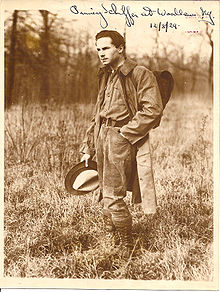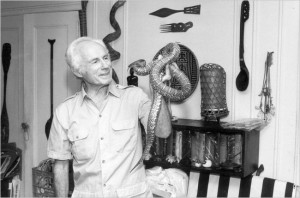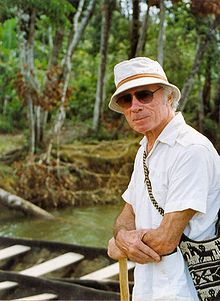
August 22, 2010

Roy Pinney in 1929.

Kim Garnick for The New York Times
Roy Pinney in 1991 with one of his snakes. He said in 1933, “I give them the run of the place.”
Roy Pinney, Man of Snakes, Baby Photos and Adventure, Is Dead at 98
By Douglas Martin, New York Times.
At 17, he was living with natives in the South American jungle and, like them, wore a loincloth, got traditional tattoos, ate monkey and danced with the gods. He fell in love with a beautiful young woman, Mina, who reciprocated. They married. She soon died of malaria, and the young man pondered suicide.
This is not a wildly atypical episode in the decidedly atypical life of Roy Pinney, who survived his youthful depression to live to be four days short of 99. He died of a stroke on Aug. 9 [2010] in Manhattan, his daughter Sara Bowman said.
The New York Sun in 1946 described Mr. Pinney as “a hard man to pin down” because of his myriad achievements. Truth to tell, he was just getting started.
He became a nationally acclaimed baby photographer, wrote two dozen books on subjects like caves and biblical animals, helped create the genre of television nature shows and survived to be one of the last journalists to have covered the Normandy invasion, in which he was wounded.
Other distinctions include making more than 160 expeditions to exotic locales, winning a prize for a short movie at a film festival in Cannes in 1963 and having a photograph exhibited at the Guggenheim in a 2004 show that included images by Henri Cartier-Bresson.
Many snakes, including some he took to grandchildren’s birthday parties, may or may not survive him. He gave them away after his first stroke several years ago. Since bagging a venomous snake as a 12-year-old Boy Scout, he caught more than 1,000 some less than an hour from Times Square and some in the deepest wilderness and always kept the best for himself.
The New York Herald Tribune in 1933 reported that he evaded eviction from his Greenwich Village apartment by moving out first hardly big news, were it not for the 30 or so serpents accompanying him. He told The Tribune he feared that marshals evicting him might harm his reptiles.
“You see, they’re not all in cases,” he explained, before interrupting the interview for a brief frolic with a six-foot rattlesnake. “I give them the run of the place. Some of them sleep on my pillow at night. The anaconda hangs out in the bathtub.”
Almost six decades later, Mr. Pinney was living in a Midtown apartment with other scaly suspects. As a reporter for The New York Times interviewed him, two king snakes each swallowed a squealing pink baby mouse. Asked if any current roommates were poisonous, Mr. Pinney, a past president of the New York Herpetological Society, hesitated.
“You’re not allowed to keep venomous reptiles in New York,” he said. “I have to answer your question that way.”
Pinyehrae Schiffer was born on the Lower East Side on Aug. 13, 1911, to Jewish immigrants from Poland who ran a grocery. He later Americanized his name.
As a young boy, he rescued injured birds from urban sidewalks. As a teenager, he worked summers as an assistant curator of entomology at the Brooklyn Museum, which then included natural history. He lost an essay contest whose prize was a wildlife moviemaking trip to Africa, but the University of Oxford accepted him for an expedition to British Guiana, the South American country now called Guyana.
The Oxford group already had an entomologist. It invited him as a photographer. Mr. Pinney had never taken a picture, but a Brooklyn news photographer taught him the basics, including how to set off a powder flash for night shots.
Thus did Mr. Pinney meet Mina and have his first experience living with a tribal people, something he would do 30 more times. He took a course at Columbia University with Franz Boas, the father of modern anthropology. It was his sole brush with higher education.
He worked as a photographer and reporter for The Daily News for eight years, then received assignments from magazines like Life. He covered D-Day for Liberty Magazine. He won four major photo contests in a row after noticing that shots of pretty girls, puppies and babies were consistent winners.
He chose babies, and in a contest by Popular Photography Magazine beat out 48,000 others to win a new Packard convertible. He did it by capturing an unusual expression on a baby’s face after offering the youngster freshly squeezed lemon juice.
He went on to start his own agency to sell stock photos, set up a company for magazine photographers to learn to shoot film for television and work as a producer and cameraman with stars of early wildlife shows like Ivan T. Sanderson, Marlin Perkins and Lorne Greene.
Mr. Pinney and his wife, the former Doris Bertelsen, who also was a photographer, combined still shots of one of their sons, Roy Jr., as he grew up to make a memorable 60-second commercial for Kodak, “Turn Around, Boys,” which won an award at a festival in Cannes. After their bitter divorce in 1971, he threw away his cameras.
Besides his daughter Sara, he is survived by his companion, Emily Geltman; two other daughters, Maria Lewis and Jackie Owens; two sons, Roy Jr. and Tor; six grandchildren; and three great-grandchildren.
When Mr. Pinney was 80 he received a call from Ms. Geltman, who saw his name in a phone book and remembered taking motorcycle rides with him when they were teenagers. She was prepared to hang up if a woman answered. Over two decades, they traveled together to many exotic places. But when they went to Guyana to look for Mina’s tribe, they found no one.

Roy Pinney (from Wikipedia)
Roy Pinney
Roy Schiffer Pinney (August 13, 1911 – August 9, 2010), was the oldest surviving of the 500 war correspondents to cover the D-Day invasion of Normandy. He lived in Midtown Manhattan in New York City, the city of his birth.
Pinney was the former president of the New York Herpetological Society and the author of The Snake Book. He was a herpetologist, professional photographer, writer, journalist, war correspondent and pilot. He was also an ardent spelunker and the author of Cave Exploration. Roy Pinney worked for the New York Daily News (Brooklyn Section, editor Jack Hoins) for 18 years working as photographer and writer, a familiar figure around New York City arriving on assignments on his motorcycle. He later freelanced for Life, Look, Colliers, and Woman’s Day and other magazines often going on his assignments in his WWII BT-13 plane.
Family history and name change
Pinney was born in 1911 as Pinyehrae Schiffer to Polish immigrant father Max Schiffer and mother Sarah Schiffer on the Lower East Side of Manhattan. His parents emigrated from Galicia in eastern Europe in the border region between Poland and Ukraine. At the age of 18 he Americanized his conspicuously Polish/Jewish name by altering his first name Pinyehrae into the last name Pinney and adopting the American first name Roy.
Roy Pinney
BiographyPinney caught his first venomous snake, a rattler, at age 12 while attending Boy Scout camp. He was chastised, but it did not take. He has since bagged more than 1,000 poisonous serpents all over the planet. The American Society for the Prevention of Cruelty to Animals gave him stray snakes in need of homes and he kept the best for himself.
The son of grocers Pinney was born and raised on the Lower East Side. His first love was photography and he was wounded photographing the Normandy invasion (“just a piece of shrapnel, nothing serious”) and shot pictures of the Yom Kippur War. He sold his work to Life and Look when they were the pinnacle. He moved on to shooting advertising photos, “where the big bucks are,” he explained, but soon became bored.
He changed his life’s course through the nature writer Ivan T. Sanderson, who each week brought a different animal to show off to Dave Garroway, the talk show host. Pinney was Sanderson’s producer and cameraman. He went on to work as cameraman for such nature show gurus as Marlin Perkins and Lorne Greene. He wrote 2,000 articles and over 20 books, about everything from tribal cultures to how to survive the atomic bomb. The last was “The Snake Book,” published in 1981. He has made more than 160 expeditions to remote destinations.
His 1971 divorce that left him so bitter he threw away all his cameras and stopped taking pictures forever. He once invested his personal savings in a new television series about a 25-year-old zoologist’s adventures, shot 39 episodes and couldn’t sell it. “She really has a special charisma with animals,” he insists to this day.
On August 9th, 2010 Pinney passed away at the age of 98, just four days before his 99th birthday.
Pinney lived in Sanderson’s former apartment, as he has since the divorce, surrounded by artifacts from endangered cultures, an undisclosed number of snakes and 50,000 aging photographs.
Herpetology
Pinney was a world traveling herpetologist who has collected venomous and non venomous snakes the world over. He was an active member of the New York Herpetological Society, serving as that organization’s president for four years ending in 1989.
Photography and films
In 1929 at the age of 18 Pinney became a freelance photographer and journalist for the Brooklyn section of the New York Daily News. He was also the camera man for a series of animal TV programs for Marlin Perkins, Ivan Sanderson and Arthur Jones. The program with Marlin Perkins was called Wild Kingdom and the program with Arthur Jones was called Wild Cargo.
Later in his career Pinney owned and operated Photo-Library Inc., a stock photography business with nearly half a million photographs on file. The library included animals, architecture, babies, children, flowers, food, geography, girls, industrial, medical, personalities, romance, scenic views and sports. On its business cards Photo-Library Inc. touted its “100,000 Color Transparencies and 300,000 Black and White stock photographs.” One of his photographs of a baby’s head taken for Popular Photography won first prize among 46,000 contenstents.
In 1964 Pinney won the award for best Commercial Film at the Cannes Film Festival.
In 2002 a 13.5×10.5 print of Pinney’s 1936 photograph of hands “Reading Braille” was displayed in the Guggenheim Museum as part of the Buhl Collection photography exhibition on hands.
In 2007 Pinney’s photograph of two swimmers underwater in a pool appeared in a large coffee table book entitled POOLS by Kelly Klein. The book was published by Rizzoli. The ISBN number is 0-8478-2918-9
Author
Pinney is the author of 24 books including The Snake Book (1981) (ISBN 0-385-13547-5), Vanishing Tribes (1968) (ISBN 0-690-85943-0), Animals of the Bible (1964) (ASIN: B0007DV4UU) and The Complete Book of Cave Exploration. Since their publication all of his books have gone out of print and have not been re-released.
War correspondent
In 1944 Pinney became a war correspondent when he covered the D-day invasion of “Omaha beach” Normandy, France for Liberty magazine. He went on to cover more than a half dozen wars and conflicts around the world including conflicts in Afghanistan, Guiana, Spanish Morocco, Colombia, the Philippines and South Africa. In 1973 Pinney also photographed and reported on the Yom Kippur War in the Gaza Strip. Among the approximately 500 war correspondents covering the Normandy Invasion Roy Pinney at 98 years old was the oldest survivor. Andy Rooney of 60 Minutes fame is also among the oldest survivors.
Friends and Associates
Pinney went to elementary school with and was lifelong friends with Bernard Herrmann who scored Citizen Kane, Psycho, and Taxi Driver. He was lifelong friends with Abraham Polonsky. He was also friends with writer Ivan T. Sanderson. Pinney moved into Sanderson’s apartment in the Whitby on 45th Street in Manhattan’s Hell’s Kitchen around the time of Sanderson’s death. He was also good friends with billionaire Arthur Jones of Nautilus, Inc. exercise equipment fame. Pinney was friends with the American photographer and model Bunny Yeager. In the book The Other Hollywood Bunny mentions Pinney in her story of the origin of the phrase “The world’s prettiest photographer” that is used to describe her. He was also friends with artist William Ward Beecher and with artist Ugo Mochi who designed his letterhead. Pinney was an early patron of George Nakashima, commissioning 18 pieces of furniture starting in 1947. Finally, Pinney was friends with John Steinbeck when Steinbeck lived in New York.
About Loren Coleman
Loren Coleman is one of the world’s leading cryptozoologists, some say “the” leading living cryptozoologist. Certainly, he is acknowledged as the current living American researcher and writer who has most popularized cryptozoology in the late 20th and early 21st centuries.
Starting his fieldwork and investigations in 1960, after traveling and trekking extensively in pursuit of cryptozoological mysteries, Coleman began writing to share his experiences in 1969. An honorary member of Ivan T. Sanderson’s Society for the Investigation of the Unexplained in the 1970s, Coleman has been bestowed with similar honorary memberships of the North Idaho College Cryptozoology Club in 1983, and in subsequent years, that of the British Columbia Scientific Cryptozoology Club, CryptoSafari International, and other international organizations. He was also a Life Member and Benefactor of the International Society of Cryptozoology (now-defunct).
Loren Coleman’s daily blog, as a member of the Cryptomundo Team, served as an ongoing avenue of communication for the ever-growing body of cryptozoo news from 2005 through 2013. He returned as an infrequent contributor beginning Halloween week of 2015.
Coleman is the founder in 2003, and current director of the International Cryptozoology Museum in Portland, Maine.
Filed under Breaking News, Cryptomundo Exclusive, CryptoZoo News, Cryptozoologists, Cryptozoology, Men in Cryptozoology, Obituaries